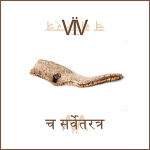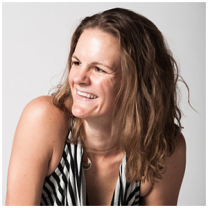 Ca Sarvetaratra, which means “and everything else,” is the latest release from the group Vive. The music exists at the intersection of ancient spirituality and modern technology, making for a divinely blissful yet energizing listening experience. Vive combines the considerable talents of vocalist/ massage therapist/ yoga instructor Tanya Witman and composer/ songwriter Gabriel Mann. The Vive Music Project is characterized as: “Tanya’s brainchild, while Gabriel is the mad scientist behind the knobs.” While they now live in Tucson and LA respectively, the pair met years ago in Philadelphia at the University of Pennsylvania while being members of a singing group. Keeping in contact over the years, they have released two albums as the group Vive.
Ca Sarvetaratra, which means “and everything else,” is the latest release from the group Vive. The music exists at the intersection of ancient spirituality and modern technology, making for a divinely blissful yet energizing listening experience. Vive combines the considerable talents of vocalist/ massage therapist/ yoga instructor Tanya Witman and composer/ songwriter Gabriel Mann. The Vive Music Project is characterized as: “Tanya’s brainchild, while Gabriel is the mad scientist behind the knobs.” While they now live in Tucson and LA respectively, the pair met years ago in Philadelphia at the University of Pennsylvania while being members of a singing group. Keeping in contact over the years, they have released two albums as the group Vive.
Tanya has been a vocalist since her earliest years. In her words: “I have sung through growing  up and going to school and getting married and divorced and moving across the country. I have sung professionally in bands, in musicals, in a multiple award-winning a cappella group, and even in a workshop with Bobby McFerrin.” These days, her voice is used as an expression of her spiritual nature, and has become part of her work as a yoga teacher. To say that Gabriel Mann has extensive credentials in the music and entertainment industry would be an understatement. In addition to being involved as a songwriter and vocalist on major films and network TV series, he has worked with some of the biggest names in music including Alanis Morissette, Katy Perry, Muse, Sara Bareilles, and even The Rolling Stones, to name but a very few. He also composes music for the video game industry and is a member of the LA-based alternative rock band The Rescues. To fully do justice to his professional resume would take the entire space of this feature article.
up and going to school and getting married and divorced and moving across the country. I have sung professionally in bands, in musicals, in a multiple award-winning a cappella group, and even in a workshop with Bobby McFerrin.” These days, her voice is used as an expression of her spiritual nature, and has become part of her work as a yoga teacher. To say that Gabriel Mann has extensive credentials in the music and entertainment industry would be an understatement. In addition to being involved as a songwriter and vocalist on major films and network TV series, he has worked with some of the biggest names in music including Alanis Morissette, Katy Perry, Muse, Sara Bareilles, and even The Rolling Stones, to name but a very few. He also composes music for the video game industry and is a member of the LA-based alternative rock band The Rescues. To fully do justice to his professional resume would take the entire space of this feature article.
 In an exclusive interview I asked Tanya about her collaboration with Gabe on the Vive Music Project. As she shared: “The reason we created this album, as well as the previous one, was because as a long-time massage therapist I have heard a great deal of music in the genre. I asked Gabe about creating some music for massage and yoga that had a great groove and feel to it. He was open to the idea and several months later we recorded our first album. It was well received and several years passed. In the meantime I started playing harmonium and singing at the end of yoga classes. By the time we were ready to record again, I had a number of new songs ready to go, and as before, Gabe brought his remarkable ear and ability to conjure an atmosphere to the music.”
In an exclusive interview I asked Tanya about her collaboration with Gabe on the Vive Music Project. As she shared: “The reason we created this album, as well as the previous one, was because as a long-time massage therapist I have heard a great deal of music in the genre. I asked Gabe about creating some music for massage and yoga that had a great groove and feel to it. He was open to the idea and several months later we recorded our first album. It was well received and several years passed. In the meantime I started playing harmonium and singing at the end of yoga classes. By the time we were ready to record again, I had a number of new songs ready to go, and as before, Gabe brought his remarkable ear and ability to conjure an atmosphere to the music.”
The musical chemistry between them is tangible. After hearing the depth and detail in this latest production, I was astounded to learn that it was all recorded in just a day and a half! Gabe’s many years of experience in the studio is certainly evident here. Tanya calls the recording experience “seamless and effortless.” She goes on to say: “Gabe’s and my musical communication is so easy. We need very few words.”
However there are many words within the music itself, which is based on mantras or sacred phrases and kirtan or devotional chanting. These practices, which stem from ancient spiritual traditions, are enjoying a renaissance within the new age music genre. According to Tanya: “When I first encountered mantra years ago it spoke to me deeply. That these small little statements had been in practice for so many years, that they spoke so simply and truthfully, I think that was what drew me to them. And I think that’s a piece of what people love about them. I also think that there are not as many community-oriented activities in day-to-day life as there used to be. I think people crave community and connection. Kirtan brings that in practice, and mantra, even recited alone, connects us to a lineage of people who have recited these same things over countless years, offering up hopes and wishes and pain to a sort of everyday magic, a transformational process.”
The album begins with a track called “Ganesh, “ who in the Hindu pantheon is a deity known as the remover of obstacles, and blesses new endeavors and new beginnings – so an appropriate choice for the opening track. Interestingly, unlike a lot of music in this genre, which features traditional Indian instruments like sitar, tamboura, and tabla drums, the sound here is strictly contemporary Western electronic. A down-tempo drum groove sets the pace, layered with percolating sequencers, synthesizers, electric piano, and more. When Tanya’s chanted vocals come in, they offer a more organic element to the mix. Although again, unlike some music in this genre, her voice is treated with effects like reverb and delay, which allow the syllables to trail off at the end of a phrase. It’s a very cool addition and brings these ancient chants more effectively into a modern ambient context. Tanya has a beautiful voice that is perfect for this kind of devotional singing, and her years of spiritual practice impart an authenticity to the chants.
I had an interesting surprise on the second track, entitled “Heart Sutra (All I Want Is You.) Although I read the title, the second part of it in parenthesis didn’t register in my mind until, in the midst of the track, I heard Tanya singing a verse from the song of that name by the rock group U2. It was masterfully woven in and expanded in an atmospheric style that it took me a moment to realize what it was. The way it is layered on top of Tanya’s echoed repeating Sanskrit vocals was pure magic and gave me chills when I first heard it.
In a shift from the preceding songs, track 3, “Gayatri,” features no drum beat, but is a haunting, ethereal chant with a more traditional Eastern sound, that floats over subtle synthesizer textures in the background. While some of the mantras on the album originate from the Hindu faith, a track called “Panca Bala,” refers to the five strengths of Buddhism: faith, effort, mindfulness, concentration and wisdom. And speaking of this particular spiritual path, a track called “Medicine Buddha,” is based on a chant that was passed on to Tanya in Santa Fe several years ago by a visiting Tibetan lama. According to the liner notes, it is intended to bring healing to oneself and others, invoking the healing aspect of the Buddha. A most unusual musical addition is the high-pitched sound of a bowed glockenspiel in the middle of the song.
Tanya related a fascinating story to me about the next to the last track on the album, which she played one day in her yoga class, and an encounter with a woman who she had never seen before: “After the class was finished she came up to me and remarked that she had come to yoga that day because she had just attended her mother’s funeral ad she needed a yoga class to help her release and relax. She shared that during that song she had seen her mother, smiling, happy and free. She told me with tears in her eyes that she and her mother had had a difficult relationship prior to her death and that she had felt a healing then. The song that I played was Maha Mrityunjaya, the mantra whose purpose is to help the transition from life to death…”
I have had the opportunity to hear a number of albums that feature mantra chanting and  devotional singing in a contemporary context, but this new release by Vive has to be one of my favorites. The angelic tone and spiritual sincerity of Tanya’s voice lifts this recording to lofty heights. I also can’t say enough about the exquisitely crafted musical soundscapes Gabriel has created to accompany the vocals. Each one is unique and could actually stand alone as an instrumental ambient recording in itself. I can easily see why he is in such great demand in the music and entertainment industry. The alchemical combination of these two extremely talented artists makes Vive a group I know we’ll be hearing more about in the future.
devotional singing in a contemporary context, but this new release by Vive has to be one of my favorites. The angelic tone and spiritual sincerity of Tanya’s voice lifts this recording to lofty heights. I also can’t say enough about the exquisitely crafted musical soundscapes Gabriel has created to accompany the vocals. Each one is unique and could actually stand alone as an instrumental ambient recording in itself. I can easily see why he is in such great demand in the music and entertainment industry. The alchemical combination of these two extremely talented artists makes Vive a group I know we’ll be hearing more about in the future.



